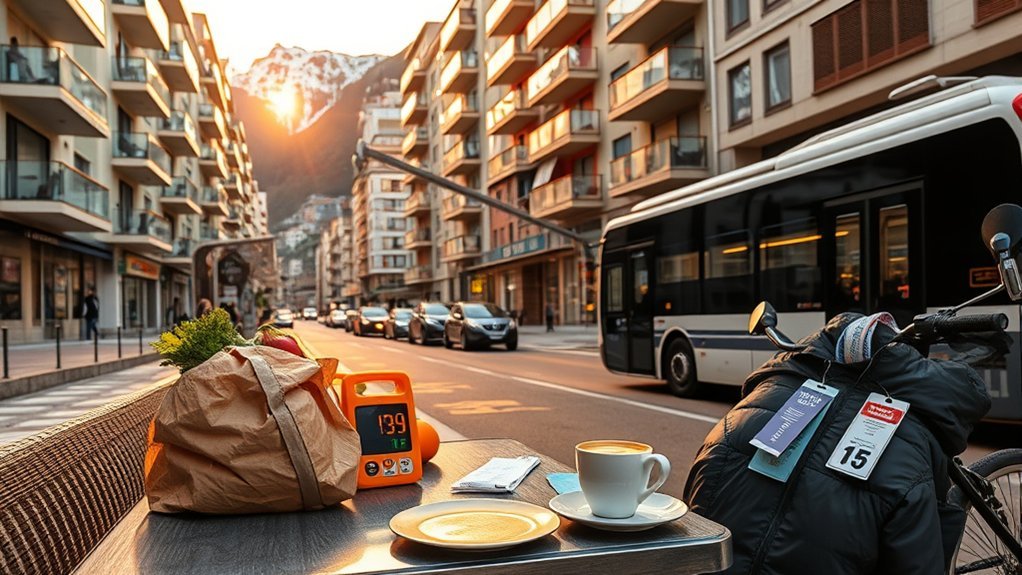You’ll find living in Andorra cheaper for everyday goods, healthcare and taxes than in Spain or France, but housing in prime towns can push costs higher. Expect rents from about €500–€1,500 monthly for typical apartments, groceries and casual dining to run noticeably lower, and utilities plus internet around €120–€150. Public healthcare and schools are affordable, taxes are low, and travel to major airports adds occasional costs—keep going for a detailed breakdown.
Safety and Community Life
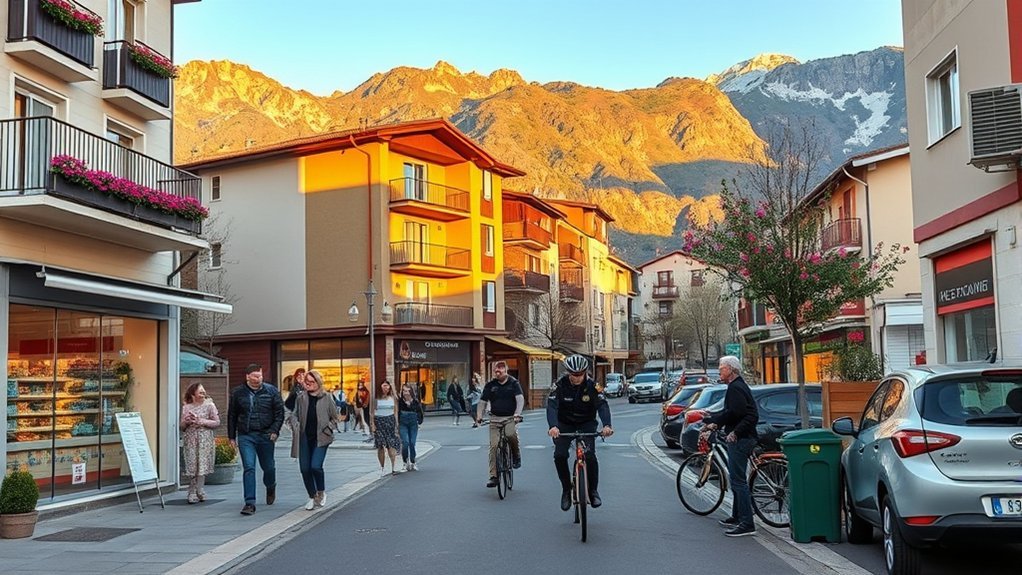
Because violent crime is almost nonexistent, you’ll quickly notice how safe daily life feels in Andorra.
Because violent crime is rare, daily life in Andorra feels remarkably safe and reassuring.
You’ll find Living in Andorra means moving through compact towns where illegal firearms are rare and tight border routes reduce serious incidents. Compared with larger countries, petty crime stays low and outdoor pursuits—skiing, biking, cycling—feel accessible without constant vigilance.
Social cohesion in narrow valleys gives you a clear safety net: neighbors know one another and community ties cut isolation. If you’re among newcomers to Andorra, follow local and international groups for faster integration; the country enjoys welcoming new residents but Catalan is official, so French or Spanish—or learning Catalan—speeds social access.
From a cost perspective, lower personal-security expenses and minimal worry about crime can offset other budget items, so Andorra’s cost of living compares favorably when you value safety. You’ll likely trade heavy urban anonymity for close-knit, secure community life that’s practical and reassuring.
Housing and Rental Prices
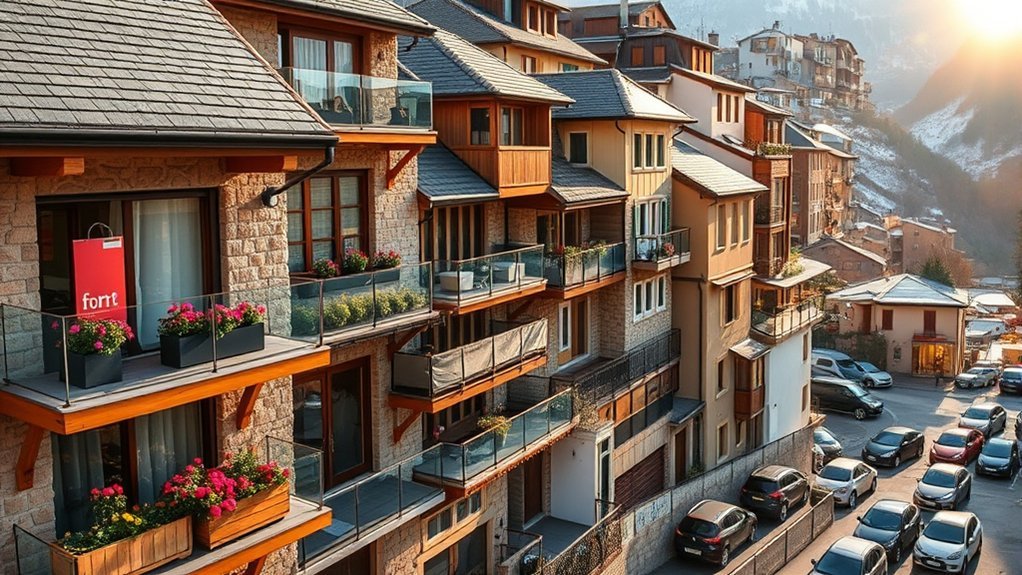
You’ll find rents in Andorra vary widely — roughly €500–€1,500/month for typical apartments, with city-center units in Andorra la Vella often from €1,000 up to €3,000 for larger homes.
Buying a 2‑bed (~80 m²) usually costs €250,000–€400,000 (around €3,268/m² advertised), so you should compare mortgage and ownership costs against recurring rent plus yearly community charges (~€1,000) and monthly utilities (~€80–€90).
Rental Price Ranges
Although Andorra’s overall cost of living can feel moderate, housing stands out as the biggest monthly expense: typical apartment rents range roughly €500–€1,500/month, with a common 2‑bed (≈80 m²) in La Massana around €650 unfurnished (parking included), while units in Andorra la Vella run higher—one‑beds commonly €1,000–€2,000 and three‑beds up to €3,000—so expect rent and related charges (community fees, utilities, internet) to dominate your budget. You’ll find cheaper options outside main towns but tradeoffs include commute and fewer services. Factor recurring costs: community fees (~€1,000/year), electricity (€80–€90/month) and internet (~€39/month). Compare listings by size, location and included bills to pick the best value for your needs.
| Type | Typical range |
|---|---|
| Studio/1‑bed | €500–€2,000 |
| 2‑bed/3‑bed | €650–€3,000 |
Buying Vs Renting
When weighing buying vs renting in Andorra, consider how much capital, stability and flexibility you want: renting keeps upfront costs low (many apartments €500–€1,500/month, with typical 2‑beds around €650 in La Massana), while buying locks you into higher initial outlays — roughly €250k–€400k for an 80 m² flat at about €3,268/m² — but can lower long‑term housing costs and build equity.
If you’re moving to Andorra short‑term or still sorting need help with residency paperwork, renting gives flexibility and lower starting expenses.
If you plan long term, buying can be cheaper per month after mortgage, though you’ll pay community fees (~€1,000/yr), utilities (electric €80–€90/mo, internet €39) and location premiums.
For finding housing, weigh cash, stability and resale when choosing life in Andorra.
Groceries, Restaurants and Daily Essentials
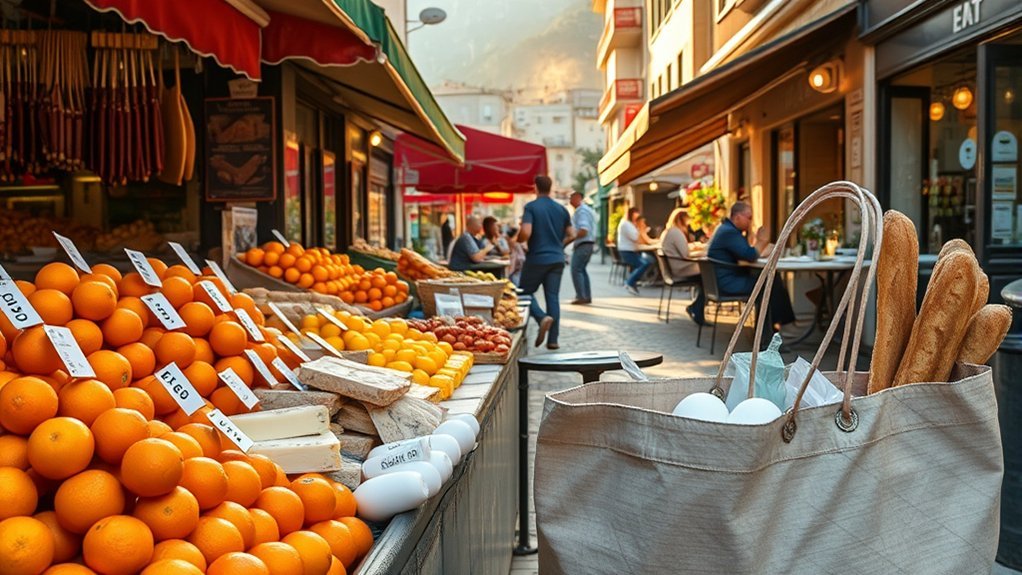
You’ll find basic groceries like tomatoes, apples and potatoes cost roughly €2–€4 per kilogram, with staples such as rice, pasta and milk under €1.50, while meat and cheese run higher (chicken ≈ €8.90/kg, beef ≈ €15.80/kg, cheese ≈ €17/kg).
Eating out is affordable for everyday meals (€8–€15 per person) with pub dinners from ≈€28 for two and mid‑range three‑course menus €25–€50.
Typical Grocery Prices
Groceries in Andorra tend to be affordable compared with many Western European countries, so you’ll find staples like a loaf of bread for about €1.20, 1 kg of rice for €1.25 and pasta near €1.20/kg.
For living budgets, plan meat at about €8.90/kg for chicken and €15.80/kg for beef, with local cheese near €17/kg (or €2.20 for 500 g).
Fresh produce is reasonable: bananas €2.20/kg, apples €1.90–€3.87/kg, tomatoes €2.00–€2.19/kg, potatoes €3.40/kg, carrots €1.50/kg.
Milk runs around €0.85/litre; supermarket beer €2.20 for 0.5 L and table wine about €19 a bottle.
Small labels like Made in Principat are common — helping existing residents spot local value — useful if you factor in groceries alongside health insurance and rent.
Eating Out Costs
Often you’ll find eating out in Andorra cheaper than in neighboring France or Spain: a basic pub dinner for two is about €28, while a mid‑range Italian meal with starters, mains, wine and dessert comes in around €36.
You’ll see casual restaurant meals priced €8–€15 per person, making weekday lunches and simple dinners affordable. A mid‑range Italian dinner for two at €36 compares favorably with similar spots abroad.
Groceries keep costs down if you cook: tomatoes €2.19/kg, apples €3.87/kg, potatoes €3.40/kg, rice €1.25/kg, pasta €1.20/kg, and chicken €8.90/kg.
Supermarket beer €2.20 (0.5 L), 2 L cola €2.65, and decent wine €19. Overall, eating out costs and supermarket prices let you balance dining out and home cooking economically.
Utilities, Internet and Household Services
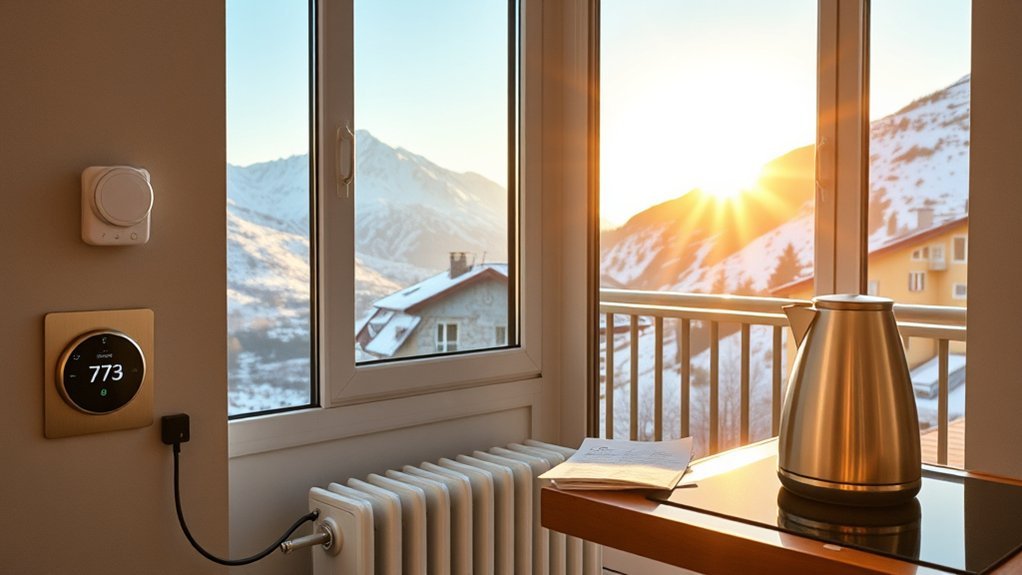
Settling into an Andorran home, expect modest monthly utility costs: electricity typically runs €80–€90, while combined bills for electricity, water and heating usually land between €80 and €150 depending on usage and property.
Expect modest utilities in Andorra: electricity around €80–€90, with combined bills typically €80–€150 monthly.
You’ll find monthly electricity predictable compared with many European cities, and household utility bills stay reasonable unless you use lots of heating in winter.
For connectivity, a 300 Mbps home internet plan costs about €39/month, so online work or streaming won’t break the bank.
If you live in a building, community service charges cover cleaning, shared heating and maintenance and average roughly €1,000 per year — factor that into your housing budget.
Water and other basics are low, but totals vary by dwelling size and habits.
Transport, Travel and Connectivity
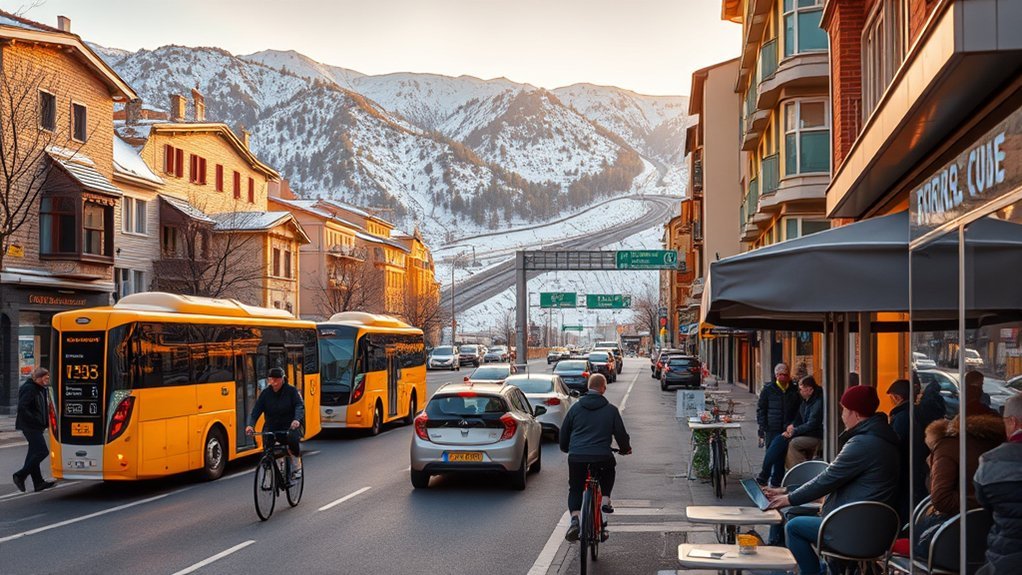
After you’ve budgeted for utilities and building charges, factor in how you’ll get around and in and out of the country. Andorra has no domestic airport or rail link; the nearest major airports are Barcelona (~2.5 h) and Toulouse (~3 h). You’ll usually rely on road transfers, private transfers or buses. La Seu d’Urgell’s small airport is pricey and limited.
| Option | Typical cost | Notes |
|---|---|---|
| Road transfers (airport) | €30–€100+ | Depends on group, season |
| Public transport (local) | Monthly ~€70 | Single taxi €1.14/km |
| Car ownership | Fuel ≈ €1.06–€1.21/l | Fees ~€100/yr; see car insurance |
Local public transport is cheap but limited for international legs, so plan connections. Fuel and low vehicle fees make driving attractive, but car insurance varies: ~€290 (TP) up to €2,500 for full cover. Compare transfer versus owning a car for frequency, cost and convenience.
Healthcare, Education and Childcare Costs
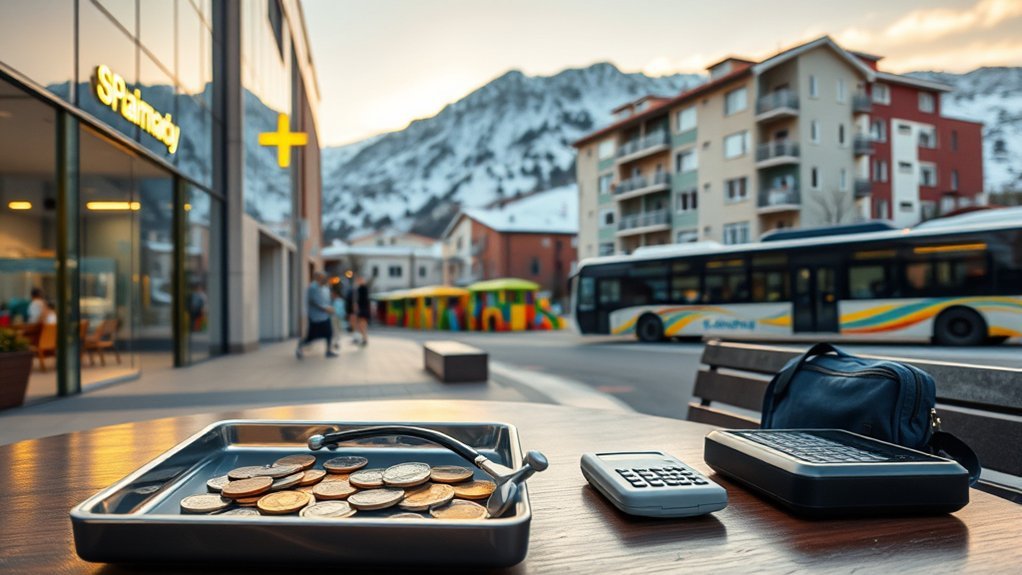
While Andorra’s public health scheme (CASS) doesn’t cover everything, it offsets a large share of costs — about 75% of outpatient visits and dental care, 90% of hospital care and 100% of childbirth — so you’ll typically pay only modest out‑of‑pocket amounts and can access affordable private care (short visits ≈ €15) and cheap medicines (cold remedies ≈ €2, common antibiotics ≈ €3).
The public health system (CASS) integrates with France and Spain, and with ~3.6 physicians per 1,000 people you’ll find good access and quality.
Public schooling is free for residents, multilingual and solid for most families; private/international tuition runs roughly €7,450–€12,750/year if you need that option.
Childcare and summer options vary: budget for summer day programs at ~€875/month or boarding summer programs near €1,975/month, plus possible supplemental language classes.
Overall, healthcare and education are competitively priced compared with neighboring countries, letting you balance public services with occasional private doctor visit convenience.
- Affordable primary care and medicines
- Free, multilingual public schooling
- Summer day programs and boarding options
Taxes, Banking and Cost Comparison
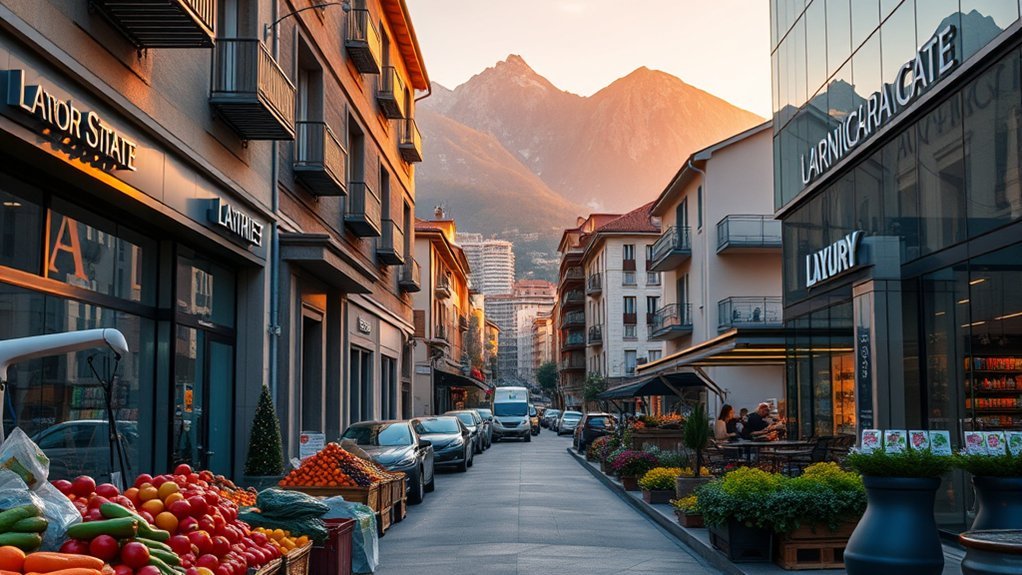
Healthcare and education costs are friendly to family budgets, but you’ll want to check taxes and banking next because they shape your net income and everyday spending.
Andorra’s tax system in Andorra is straightforward: married couples can be tax‑free up to €40,000 and a maximum personal rate of 10% applies above that. Corporate tax is also 10%, keeping business costs competitive versus nearby states. There’s no general sales tax and VAT is low at 4.5%, so routine purchases cost less than in many European countries.
Andorra keeps taxes simple: low personal and corporate rates (10%), generous couple threshold, and minimal VAT for cheaper everyday costs
Banking and residency services are well‑established locally, so you can set up accounts and handle permits without surprise. Note some international retail and online platforms may restrict Andorra, so you’ll need occasional workarounds.
Overall consumer prices are attractive—costs often ~30% below large world cities—though housing in prime spots can be pricier, so factor location when comparing total living costs.
Frequently Asked Questions
Is Andorra a Cheap Place to Live?
Yes — you’ll generally find Andorra cheaper than major European capitals and far cheaper than places like Singapore, thanks to low taxes and affordable groceries, though housing and imported goods can push costs up depending on location and lifestyle.
How Much Money Do You Need to Live in Andorra?
You’ll need roughly €3,000 monthly to live modestly in Andorra; you’ll spend about €3,116 alone as a single, less than many European cities, though housing or family costs can raise that to €5,000+.
Is Living in Andorra Worth It?
Yes — you’ll likely find it worth it if you value safety, low taxes, outdoor life and good healthcare; you’ll trade easier travel, bigger markets and some convenience for lower living costs, strong public services and excellent recreation.
What Is the Average Price of a House in Andorra?
Average house prices in Andorra vary: expect roughly €250,000–€400,000 for a 2‑bed apartment (around €3,268/m² median), while larger or prime homes commonly exceed that, especially in Andorra la Vella and ski areas.
Conclusion
Living in Andorra gives you quiet safety and lower taxes, but costs vary: rent and groceries beat many Western European cities while private schooling or international healthcare can add up. You’ll save on income tax and enjoy efficient transport, yet utilities and imported goods cost more than in Spain. Weigh lifestyle against expenses—think of Andorra as a sleek, compact wallet that fits comfortable living but still needs careful budgeting to avoid surprises.

